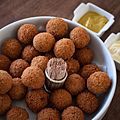Snack facts for kids
A snack is a small amount of food that people usually eat between their main meals. Snacks can be many different things. Some are packaged foods you buy, while others are made at home with fresh ingredients.
Traditionally, people made snacks from ingredients they already had at home, without much fuss. Things like fruit, nuts, sandwiches, and even sweets were often used. The idea of a huge snack was even made famous by the "Dagwood sandwich" in cartoons! As convenience stores became popular, packaged snack foods grew into a big business.
Snack foods are usually made to be easy to carry, quick to eat, and satisfying. Many processed snacks are designed to last a long time and be easy to take with you. They often contain sweeteners, preservatives, and tasty ingredients like chocolate or peanuts.
Sometimes, people eat a snack right before bed or during the night. These are often called "bedtime snacks" or "late-night snacks."
Contents
Snacks in the United States
In the United States, peanuts became a very popular snack. Peanuts first came from South America and were used in cooking on southern farms. After the American Civil War, peanuts became popular across the country, especially at baseball games and shows.
At first, snacks like popcorn (also from South America) were often sold by street vendors, and some people thought they were not very clean. During the Victorian era (1837–1901), eating food that didn't need forks and knives was sometimes seen as "lower-class."
Pretzels were brought to North America by the Dutch in the 1600s. In the 1860s, pretzels were still mostly linked to immigrants and street sellers. But during the Prohibition Era (1920-1933), when alcohol was banned, pretzel makers needed new ways to sell their snacks. They started to make pretzels more appealing to everyone.
As new packaging made snacks safer and easier to advertise with a logo, pretzels became super popular. This helped many other types of snack foods grow too. By the 1950s, snacking was a favorite American activity, known all over the world.
Snacks in Asia
Indonesian Snacks
Indonesia has many different snacks called kue, which means cakes and pastries. These can be both savory (salty) and sweet. Traditional kue are often made from rice flour, coconut milk, and coconut sugar. They are usually steamed or fried, not baked.
Traditional kue are known as kue basah ("wet kue") because they are moist and soft from the coconut milk. Kue kering means "dried kue" and is the local name for cookies. Indonesia has a huge variety of kue, some are native to the country, and others were influenced by foreign cultures.
Crunchy Crackers
Traditional crackers in Indonesia are called krupuk. They are made from things like shrimp, fish, vegetables, or nuts. People eat krupuk as a crunchy snack on their own or with main meals. Some Indonesian dishes, like gado-gado, even need a specific type of krupuk as a topping to add a crunchy texture.
There are many kinds of krupuk in Indonesia. The most popular ones are krupuk udang (prawn crackers) and krupuk kampung (cassava crackers). Other popular types include krupuk kulit (dried buffalo-skin crackers), emping melinjo (crackers from the gnetum gnemon tree), and kripik (chips or crisps). Examples of kripik are kripik pisang (banana chips) and keripik singkong (cassava chips).
Rempeyek is a cracker made from flour with bits of peanuts, anchovies, or shrimp inside. Rengginang or intip (in Javanese) is a rice cracker made from leftover rice that is sun-dried and then deep-fried.
Japanese Snacks
Japan has a very wide range of snack foods. These include things like onigiri (rice balls) and Melon pan (a sweet bread). You can find more details about these and other snacks in articles like List of Japanese snacks and Japanese cuisine.
Malaysian Snacks
- Cincin - a deep-fried pastry snack popular in East Malaysia.
- Roti john - a spiced meat omelette sandwich, often eaten for breakfast or as a snack.
- Bakkwa (Chinese: 肉干) - this means "dried meat," but it's really like barbecued meat jerky. It's very popular during Chinese New Year but is eaten all year round as a snack.
- Idli - made from a mix of black lentils and rice, shaped into patties and steamed. Idlis are eaten for breakfast or as a snack, usually with vadai (donut-shaped fritters), chutney, and a lentil and vegetable stew called sambar.
- Murukku - a savory (salty) snack of spiced crunchy twists made from rice and lentil flour. It's traditionally eaten during Deepavali.
- Vadai, vada, or vades - a general name for many types of savory fritter snacks from South India. They often contain lentils, chilies, onions, and curry leaves.
- Tebaloi - a sago biscuit snack from the Melanau people of Sarawak.
- Pisang goreng - a common snack sold by street vendors. These are battered and fried bananas. They can also be served as a dessert in cafes. Other fruits and root vegetables are sometimes fried in the same way.
Thai Snacks
- Miang kham – dried shrimp and other ingredients wrapped in cha plu leaves. It's often eaten as a snack or a starter.
- Sai ua – a grilled sausage made of ground pork mixed with spices and herbs. It's often served with fresh ginger and chilies and sold as a snack in markets, especially in Chiang Mai.
Snacks and Your Health
Healthy snacks are those that have important vitamins, and are low in unhealthy fats, added sugars, and sodium (salt). Here are some examples of healthy snacks:
- Eggs, like hard-boiled eggs
- Fruits and vegetables
- Lean cheese
- Lean meats
- Low-fat dairy products
- Nuts and seeds
- Foods made with whole grains
Eating Habits and Health
Organizations like Health Canada suggest that people try to eat more healthy, natural snacks. This means choosing things like fruit, vegetables, nuts, and cereal grains. They also recommend avoiding high-calorie, low-nutrient junk food.
A study in 2010 showed that children in the United States snacked about six times a day. This was twice as often as American children did in the 1970s. This means they were eating about 570 more calories each day than kids in the 1970s.
Snacks and Thinking Skills
A study from Tufts University looked at how an afternoon snack affects thinking skills needed for learning. They found that eating a sweet snack in the afternoon helped improve spatial memory (remembering where things are) in the group they studied. However, it had mixed effects on how well people paid attention.
Types of Snack Foods
- Almonds
- Apple slices
- Bagel with cream cheese
- Bitterballen
- Candy bar
- Carrot Chips
- Cashews
- Cheese
- Cheese puffs/cheese curls
- Chocolate-coated marshmallow treats
- Corn chips and Tortilla chips
- Cocktail sausage
- Cookies
- Crackers
- Deviled eggs
- Doughnuts
- Dried fruits
- Drinkable yogurt
- Edamame, fresh or dried
- Granola bars
- Falafel
- Flour tortilla with a filling
- Frozen berries
- Fruit cocktail
- Fruit salad
- Ice cream
- Jell-O
- Jerky
- Kaassoufflé
- Milkshake
- Pound cake, in slices
- Lunchables
- Mixed nuts
- Muffins
- Papadum
- Peanuts
- Pita bread
- Popcorn
- Pork rinds
- Potato chips
- Pakoda
- Pretzels, hard or soft
- Raisins
- Ratatouille, served cold
- Rice cake
- Rice crackers
- Saltines
- Samosa
- Seeds (sunflower or seed mix)
- Shortbread
- Sliced fruit
- Smoked salmon
- Smoothie
- Teacake
- Trail mix
- Vegetables (e.g., carrots, celery, cherry tomatoes)
- Whole fruit
- Yogurt
Image gallery
Images for kids
See also
 In Spanish: Snack para niños
In Spanish: Snack para niños






















